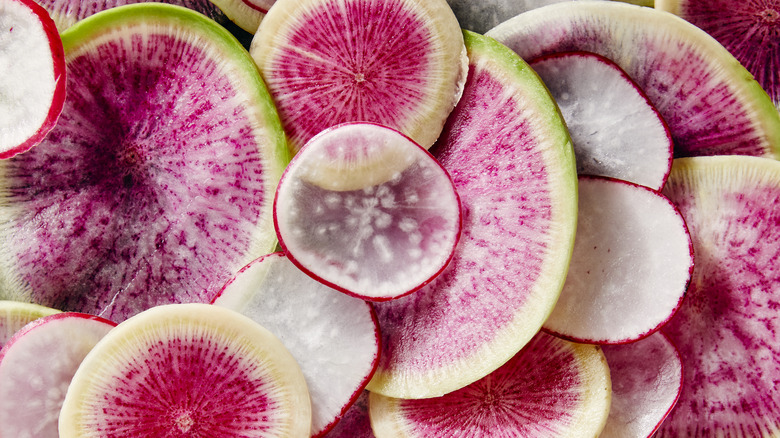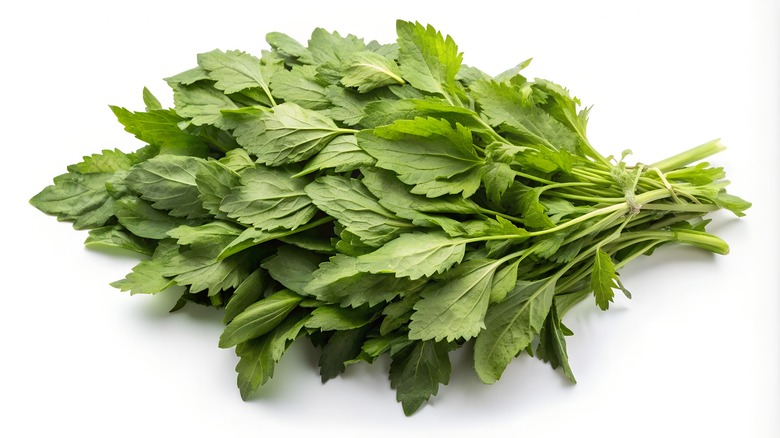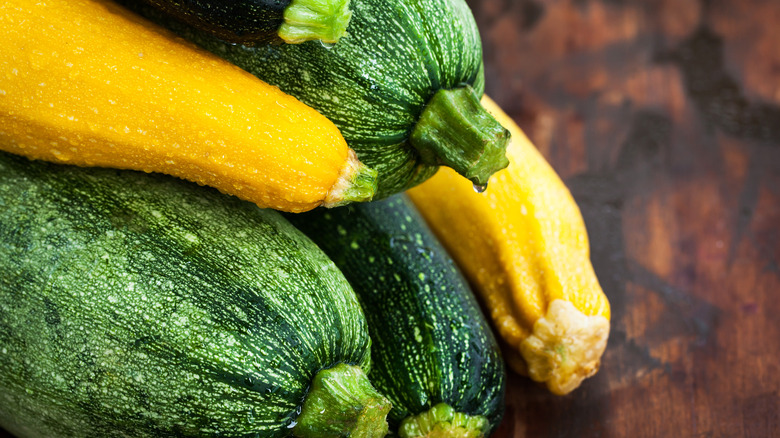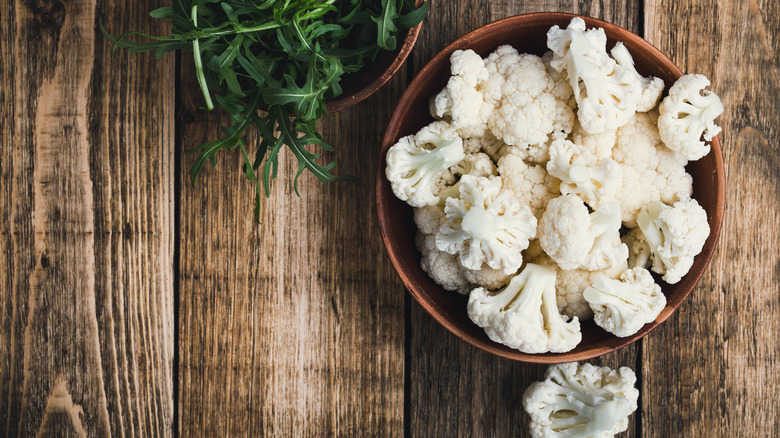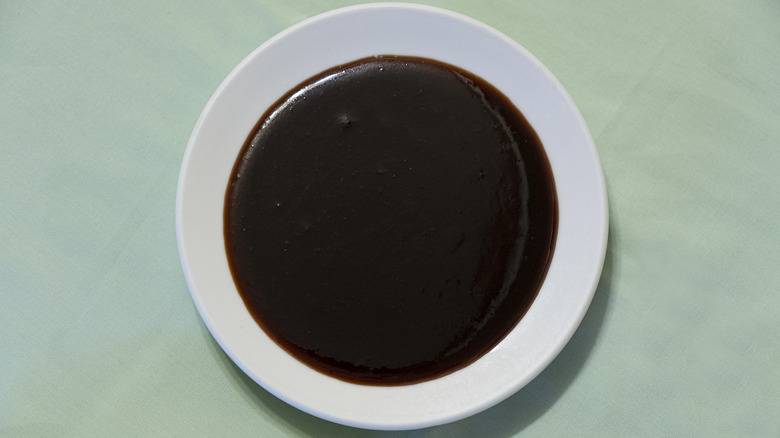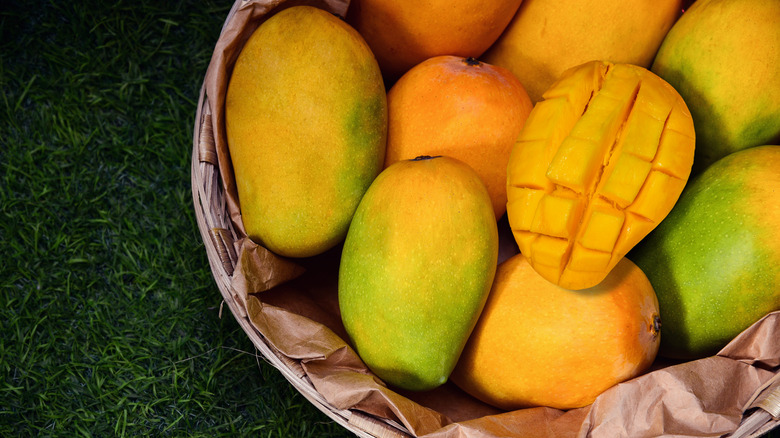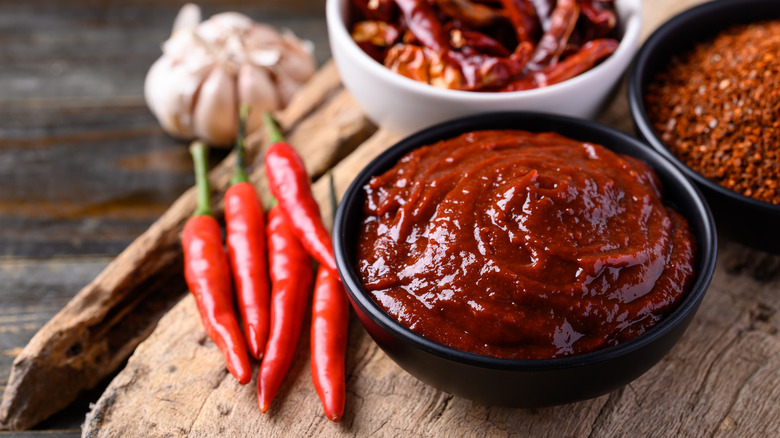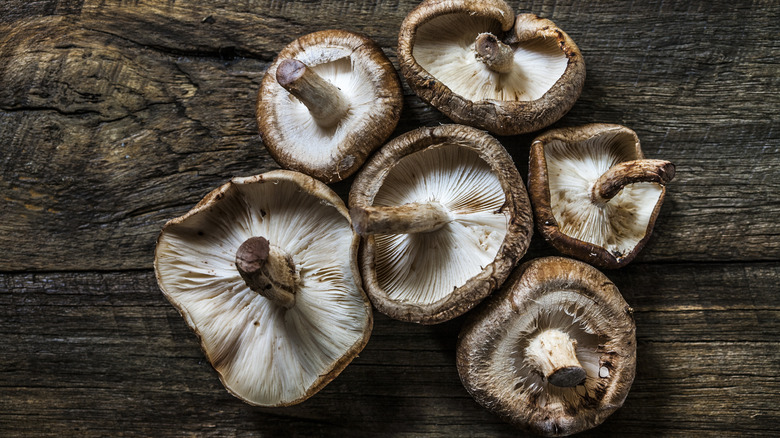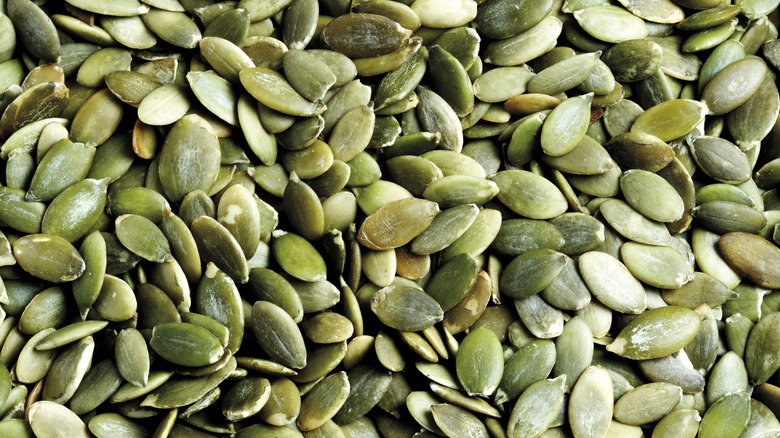11 Chef-Recommended Ingredients To Try In Your Next Bowl Of Chili
There are a few staples you probably always include in your chili rotation: beans, tomato, cumin, chili powder, and garlic, to name a few. However, there are countless fresh ingredients out there that can take any traditional, cozy chili recipe to the next level. We spoke with culinary consultant chef Gigi Gaggero and chef/co-owner of Mill & Main in Kerhonkson, NY, Claudia Sidoti, to gain their professional insights on some unexpected ingredients that will transform chili from average to extraordinary. "Be creative and have fun. Remember chili is a layering of flavor — you can create a great base and then rely on toppings to boost everything," says Sidoti.
While canned staples can elevate chili — think chipotle in adobo or pumpkin puree — look to the fresh produce aisle or sauces to infuse your favorite chili recipe with unexpected flavors, whether that's added umami or a hint of sweetness. No matter what you prefer, read on to discover our 11 favorite chef-recommended ingredients to add to your next batch of chili.
1. Radishes
Add a refreshing bite to your favorite chili by topping it with fresh radish slices. This cruciferous vegetable is a nutritious, heart-healthy alternative to common dairy-heavy chili toppings like crema, sour cream, or cheese. "Crispy fried shallots or onions add a delightful crunch, while tangy pickled jalapeños or sliced radishes provide a zesty kick," chef Gigi Gaggero explains. Radishes have a peppery, almost spicy flavor that, when eaten raw, complements common chili spices like cumin, garlic, and chili powder. They also add a textural contrast thanks to their super crunchy bite.
You can experiment with different radish varieties to find your favorite. While the mild cherry belle variety is most commonly found in grocery stores, there are countless other options to explore. Consider black radishes for their bolder, more intense flavor, or slice up a striking watermelon radish to add subtle peppery flavors and a beautiful visual finish to your next bowl of chili. For even more complex flavors, you can also pickle your favorite radish varieties. Use them as a chili topping to infuse each spoonful with a vinegary, acidic finish.
2. Epazote
While cilantro is a staple herb in many households, there's an alternative chili topping you can use to switch up the flavor of your next batch: epazote. "Fresh herbs like cilantro or epazote can provide a vibrant finish to the dish," chef Gaggero tells Mashed. Commonly used throughout Mexico and Guatemala, this herb — also known as "Mexican tea" — has a strong flavor similar to other herbs like anise, fennel, or tarragon. Often found in popular Mexican dishes like tamales or chilaquiles, it is a versatile ingredient that can be used both fresh and dried.
Though it can be a polarizing topping (like cilantro) because of its pungent flavor, it is commonly used in black bean dishes, making it the perfect complement to a bean-heavy chili recipe. As an added perk, it's also highly regarded for its gas-relieving effects (which is never a bad quality after consuming a bowl of chili).
3. Squash
"To elevate a chili recipe and set it apart from traditional versions, consider incorporating fresh, seasonal ingredients that add layers of flavor and texture," recommends chef Gigi Gaggero — and squash is the perfect option. This hearty fruit can not only withstand the long cooking times many chilis require, but it will also infuse the dish with a subtle sweetness. Though there are many squash varieties with a range of flavors, they are typically slightly sweet, mild, and a bit nutty.
While butternut squash is a common option for chilis, consider trying other squash varieties like zucchini, acorn, pumpkin, or summer squash. You can even roast a spaghetti squash and use it instead of a starchy side as a base to serve chili for a more nutritious alternative. Just be sure to familiarize yourself with the differences between summer and winter squash to ensure you choose the right variety depending on the time of year.
Besides the delicious flavor and smooth texture, squash also offers numerous health benefits. It can help improve blood pressure, enhance gastrointestinal health, and even boost your dental health.
4. Cauliflower
While squash is a delicious option, there are other hearty vegetables you can use to help beef up your chili — both in terms of nutritional value and texture. Cauliflower is a versatile ingredient that you can add to almost any chili recipe to increase the nutrient density, as it's filled with vitamins C and K, and folate.
Because it is a fairly hearty vegetable, cauliflower florets can be added to your chili early on to simmer with the other ingredients without any danger of becoming too mushy. You can even buy the pre-cut bags at the store to save on prep time instead of breaking down a head of cauliflower yourself. Claudia Sidoti recommends cauliflower rice, too. "In a white or veggie chili, try using cauliflower rice in addition to ground chicken or turkey," she says. Just be sure to add it at the very end of the cooking time to prevent it from becoming soggy.
5. Sweet potato
Sweet potatoes are the perfect way to add a touch of sweetness to chili. Once cooked, the starch in these potatoes converts into sugar, creating a mild, sweet flavor that is the perfect complement to the common umami flavors of chili from beef, beans, and tomatoes. While they taste great, sweet potatoes are also a vitamin- and mineral-packed ingredient; they boast impressive levels of antioxidants, fiber, and potassium, as well as vitamins A, C, and B6.
You can add cubed pieces of this delicious starchy vegetable into the chili itself, or serve your favorite recipe overtop a roasted sweet potato. "I also love using a baked or sweet potato as a base for fully loaded chili!" Claudia Sidoti adds. Along with chili, top the potato with corn, black beans, chives, and Greek yogurt or sour cream for a mouthwatering loaded baked sweet potato that makes the perfect healthy and satisfying meal.
6. Dark chocolate
A few classic Mexican dishes, like authentic mole, are known for using dark chocolate to enhance the richness of flavor. So why should chili be any different? Using high-cocoa content dark chocolate (even better if it's Mexican chocolate) adds depth and helps cut through the acidity of the tomato base. According to chef Gigi Gaggero, you only need to add "a hint of dark chocolate for a luxurious richness" to your favorite chili recipe.
When choosing the chocolate to use in your recipe, just make sure it's dark chocolate, not milk. Because of the higher sugar content, milk chocolate can throw off the final flavor of your chili. Semisweet and bittersweet chocolate, on the other hand, typically have between 50 and 65% cacao or more, giving them a bit of a bitter taste. Which dark chocolate you use depends on personal preference, but either option delivers a slightly bitter note that blends well with spices like cumin, chili powder, and paprika.
7. Soy, fish, or Worcestershire sauce
Adding a satisfying umami kick to your chili can be a challenge. While beef broth or ground beef will give it a meaty, rich taste, there are other alternatives you can add to your chili to get that sought-after salty, savory bite. "To enhance the umami factor, consider adding a splash of soy sauce, fish sauce, or Worcestershire sauce to amplify the savory notes! These are my secret weapons, actually," chef Gigi Gaggero explains.
While these three types of sauces may seem dramatically different at first glance, they actually have a lot of similarities. The salt content and intense umami flavor are the same across all three — which is likely why they are often recommended as substitutes for one another. Fish sauce and Worcestershire sauce, however, contain anchovies as one of the ingredients, giving them a slight fishy flavor. Soy sauce, on the other hand, contains an element of sweetness. Try each sauce in your chili to determine which flavors you like best.
8. Mango
Juicy, fresh mango has a sweet, tropical taste and sometimes even a zesty zing depending on its ripeness. Often compared to fruits like pineapple or peach, mango is regularly paired with spices typically found in chili, such as chili powder, cumin, and garlic. Whether used in tacos, salsa, or other Mexican-inspired favorites, mango contrasts with mild or even high levels of spice and savoriness, making it the ideal sweet fruit to add to your next batch of chili.
There are a few ways you can include mango in your recipes. First, you can cook down a fresh mango, breaking down the fibers, intensifying the flavor, and creating a jammy consistency. This method creates a delicious blend of flavors for a unique chili dish. Alternatively, you can also use fresh mango as a topping with your regular chili recipe for something more subtle — you can even practice cutting the mango in an aesthetically pleasing way for a more professional finishing touch.
9. Gochujang
Instead of using classic chili powder or peppers like poblanos, jalapeños, or serranos in your chili, opt for something more unexpected: gochujang. This Korean staple, made with chili powder, garlic, and fermented soybeans, creates a spicy, salty, and totally distinct flavor. While it tastes delicious, the ingredient is also filled with nutrients like vitamin C and A, fiber, and iron.
Unlike other popular hot condiments, gochujang isn't supposed to be added as a topping to dishes once they're already cooked — instead, it's designed to complement other flavors in a recipe while cooking for added depth. "From selecting the perfect blend of spices to achieving the ideal balance of heat and sweetness, every step of the [chili-making] process allows creativity and experimentation in the kitchen," says chef Gigi Gaggero.
While it may be a bit unexpected, gochujang is perfect for adding heat and complexity to your favorite chili recipe. You just need a few tablespoons of this paste for an intense, well-rounded flavor. Sub it into your next batch instead of tomato paste for a new twist on a classic recipe.
10. Mushrooms
While they're not a classic chili ingredient, certain mushrooms are great for enhancing your chili's texture and flavor — and the nutrient density. This tasty veggie is a good source of protein, fiber, and minerals like selenium and magnesium.
The rich, earthiness of mushrooms is the ideal way to add depth and umami to your dish without any animal proteins or byproducts. These versatile vegetables can also provide a meaty texture for your chili (especially varieties like portobello or shiitake) to make it feel heartier. You can even remove the meat entirely and swap in mushrooms for a vegetarian or vegan dish.
Try pan roasting the mushrooms in butter before adding them to the chili to help evaporate some of the natural liquid and give them a nice golden color that boosts their natural flavor. As an added perk, the fat soaks into the mushrooms, giving them a restaurant-quality taste.
11. Pumpkin seeds
While pumpkin seeds might make you think of Halloween, Thanksgiving, or autumnal dishes, they can be incorporated year-round as a chili topping to add flavor and texture. These small-but-mighty seeds are packed with omega-3 fatty acids and fiber and have anti-inflammatory effects thanks to their high levels of antioxidants.
In addition to their plentiful health benefits, pumpkin seeds — also called pepitas when shelled — have a delicious, earthy taste. While they have a mild flavor, they offer a nutty finish that is more pronounced once the seeds are roasted. To enhance the flavor of your chili topping, first season the seeds with your preferred oil and spices. While they taste delicious with just a hint of salt, you can also get creative and add herbs and spices like garlic powder, paprika, or even chili powder for a kick.
Once prepped, spread the pepitas in a single layer on a baking dish and roast them at 350 F for 10 to 15 minutes, stirring them half way. The result is delicious, crispy seeds that add unbeatable texture to any chili recipe. For alternatives with similar crunch, chef Claudia Sidoti recommends, "crispy fried onions, chopped roasted peanuts or toasted sesame seeds ... to jazz up a chili."

